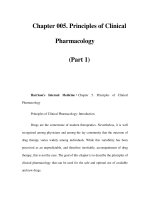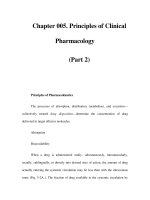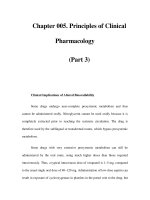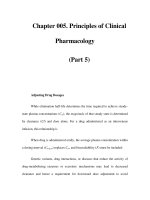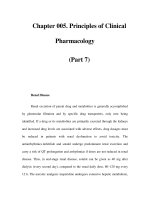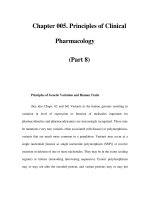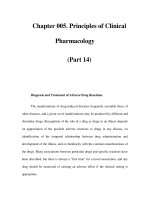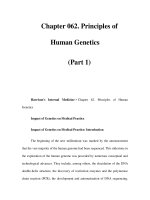Chapter 062. Principles of Human Genetics (Part 22) pot
Bạn đang xem bản rút gọn của tài liệu. Xem và tải ngay bản đầy đủ của tài liệu tại đây (46.98 KB, 5 trang )
Chapter 062. Principles of
Human Genetics
(Part 22)
Inherited mitochondrial disorders are transmitted in a matrilineal fashion;
all children from an affected mother will inherit the disease, but it will not be
transmitted from an affected father to his children (Fig. 62-11D ). Alterations in
the mtDNA affecting enzymes required for oxidative phosphorylation lead to
reduction of ATP supply, generation of free radicals, and induction of apoptosis.
Several syndromic disorders arising from mutations in the mitochondrial genome
are known in humans and they affect both protein-coding and tRNA genes (Table
62-1 and Table 62-5). The broad clinical spectrum often involves
(cardio)myopathies and encephalopathies because of the high dependence of these
tissues on oxidative phosphorylation. The age of onset and the clinical course are
highly variable because of the unusual mechanisms of mtDNA transmission,
which replicates independently from nuclear DNA. During cell replication, the
proportion of wild-type and mutant mitochondria can drift among different cells
and tissues. The resulting heterogeneity in the proportion of mitochondria with and
without a mutation is referred to as heteroplasmia and underlies the phenotypic
variability that is characteristic of mitochondrial diseases.
Table 62-5 Selected Mitochondrial Diseases
Disease/Syndrome OMIM
#
MELAS syndrome: mitochondrial myopathy with
encephalopathy, lactacidosis, and stroke
540000
Leber's optic atrophy: hereditary optical neuropathy 535000
Kearns-Sayre syndrom
e (KSS): ophthalmoplegia, pigmental
degeneration of the retina, cardiomyopathy
530000
MERRF syndrome: myoclonic epilepsy and ragged-
red
fibers
545000
Neurogenic muscular weakness with ataxia and retinitis
pigmentosa (NARP)
551500
Progressive external ophthalmoplegia (CEOP) 258470
Pearson syndrome (PEAR): bone marrow and pancreatic
failure
557000
Autosomal dominant inherited mitochondrial myopathy
with mitochondrial deletion (ADMIMY)
157640
Somatic mutations in cytochrome b
gene: exercise
intolerance,
lactic acidosis, complex III deficiency, muscle pain,
ragged-red fibers
516020
Acquired somatic mutations in mitochondria are thought to be involved in
several age-dependent degenerative disorders affecting predominantly muscle and
the peripheral and central nervous system (e.g., Alzheimer's and Parkinson's
disease). Establishing that a mtDNA alteration is causal for a clinical phenotype is
challenging because of the high degree of polymorphism in mtDNA and the
phenotypic variability characteristic of these disorders. Certain pharmacologic
treatments may have an impact on mitochondria and/or their function. For
example, treatment with the antiretroviral compound azidothymidine (AZT)
causes an acquired mitochondrial myopathy through depletion of muscular
mtDNA.
Mosaicism
Mosaicism refers to the presence of two or more genetically distinct cell
lines in the tissues of an individual. It results from a mutation that occurs during
embryonic, fetal, or extrauterine development. The developmental stage at which
the mutation arises will determine whether germ cells and/or somatic cells are
involved. Chromosomal mosaicism results from non-disjunction at an early
embryonic mitotic division, leading to the persistence of more than one cell line,
as exemplified by some patients with Turner syndrome (Chap. 343). Somatic
mosaicism is characterized by a patchy distribution of genetically altered somatic
cells. The McCune-Albright syndrome, for example, is caused by activating
mutations in the stimulatory G protein α (G
s
α) that occur early in development
(Chap. 347). The clinical phenotype varies depending on the tissue distribution of
the mutation; manifestations include ovarian cysts that secrete sex steroids and
cause precocious puberty, polyostotic fibrous dysplasia, café-au-lait skin
pigmentation, growth hormone–secreting pituitary adenomas, and hypersecreting
autonomous thyroid nodules (Chap. 341).
